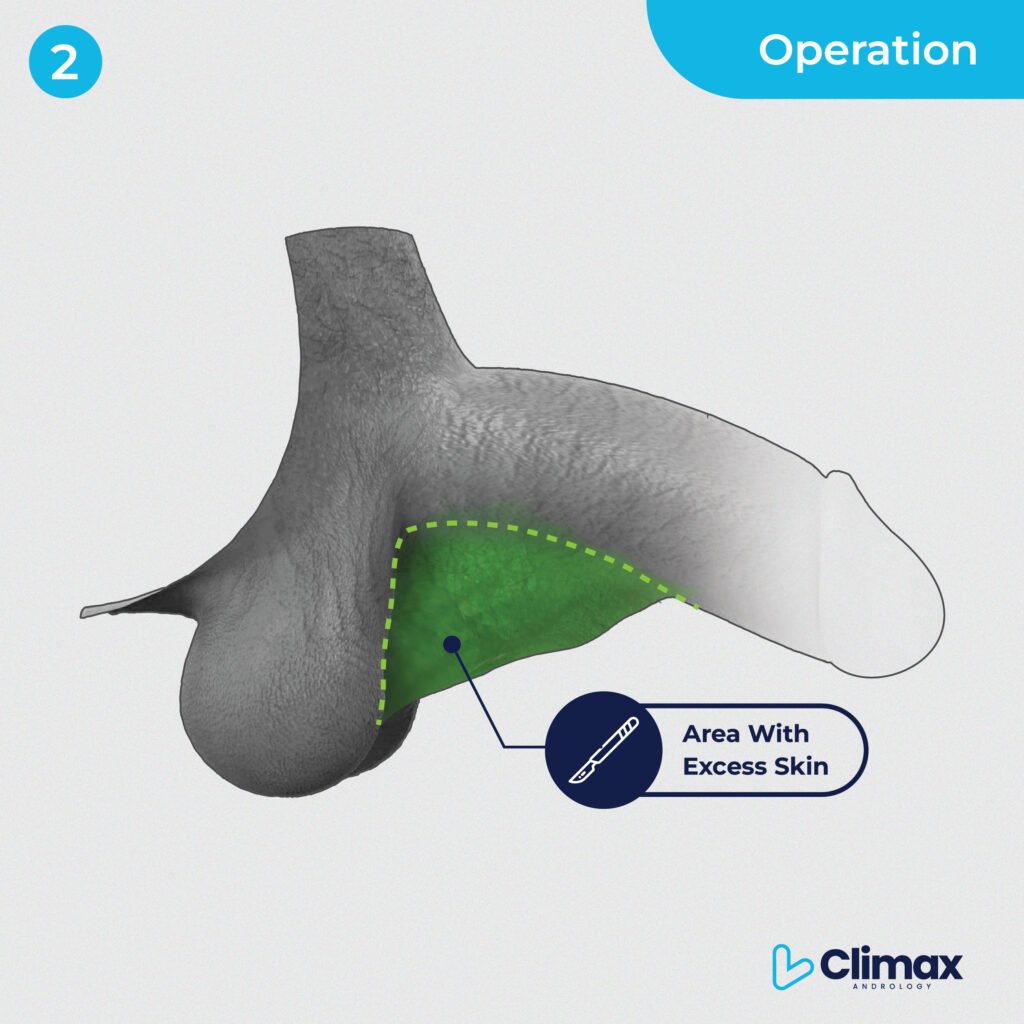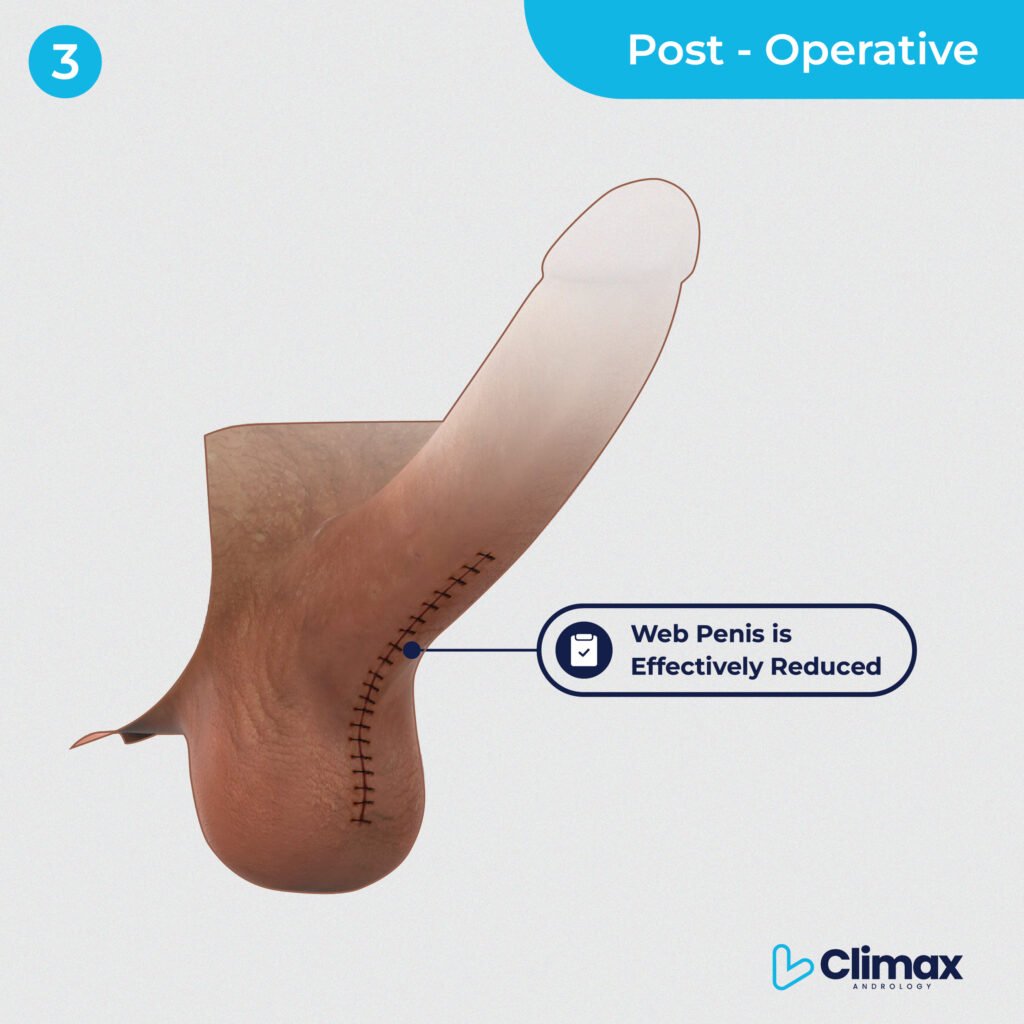Scrotoplasty Surgery / Scrotal Webbing
What is Scrotalplasty (Scrotal Webbing Surgery) ?
Scrotalplasty is a specialised surgical procedure that corrects deformities or functional issues with the scrotum, the pouch of skin that holds the testicles. This surgery may be necessary for various reasons, including congenital conditions, injuries, cosmetic concerns, or complications from other treatments.
A common reason for scrotalplasty is to correct scrotal webbing, also known as penoscrotal webbing or penoscrotal fusion. This condition occurs when the scrotal skin attaches abnormally to the underside of the penis, creating a web-like structure. Scrotal webbing can affect both the function and appearance of the genitals, leading to physical discomfort and psychological distress.

Why Does Scrotal Webbing Occur?
Congenital Causes:
- Developmental Issues: Scrotal webbing often originates from congenital factors. During fetal development, the genital structures form and separate into the penis and scrotum. If this process is incomplete, scrotal skin may remain attached to the penile shaft, leading to penoscrotal webbing. The severity of this condition can vary from mild cases to more extensive fusions.
Acquired Causes: - Surgical Complications: Scrotal webbing can also develop due to surgical procedures, particularly circumcisions. If too much skin is removed or healing doesn’t go well, the scrotal skin can fuse abnormally with the penile shaft.
- Trauma: Injury to the genital area, such as cuts or burns, can lead to scarring that may cause or worsen scrotal webbing.
- Aging and Skin Laxity: As men age, their skin loses elasticity, leading to sagging. This can make existing webbing more noticeable or contribute to the formation of new webbing, especially if the skin becomes excessively loose.
What Problems Does Scrotal Webbing Create?
Patients with scrotal webbing may experience various issues:
Functional Impairments:
- Sexual Dysfunction: Scrotal webbing can restrict the natural movement of the penile shaft, making erections uncomfortable or painful. This restriction may cause difficulties during sexual activity, including discomfort during intercourse and psychological distress, which can impact overall sexual function.
- Hygiene Difficulties: The webbed area may trap moisture and sweat, creating an environment conducive to infections such as fungal infections or balanitis (inflammation of the glans penis). Proper hygiene can be challenging, increasing the risk of recurrent infections.
Cosmetic Concerns: - Aesthetic Dissatisfaction: The appearance of scrotal webbing often leads to dissatisfaction with the appearance of the genitals. The condition may cause the penis to appear shorter or partially buried, leading to significant distress and negatively affecting self-esteem.
- Psychological Impact:
Emotional and Psychological Effects: The combination of functional limitations and aesthetic concerns can lead to anxiety, depression, and a lower quality of life. Men with scrotal webbing may feel embarrassed in intimate situations and may avoid sexual relationships as a result.
The Surgical Procedure
The exact steps of scrotoplasty vary depending on the reason for the surgery, but generally, the process includes the following:
1. Preparation:
– The patient is given general anesthesia to ensure they are asleep and pain-free
during the procedure.
– The area where the surgery will be performed is thoroughly cleaned and
prepared.
2. Incision:
– The surgeon makes a cut (incision) in the area where the scrotum needs to be
created, repaired, or reduced.
3. Tissue Manipulation:
– Reconstruction: If the scrotum is being repaired, the surgeon reshapes or
rebuilds the tissue to form a functional scrotum.
– Reduction: If the goal is to reduce the size of the scrotum, the surgeon
removes any excess tissue.
4. Closure:
– The surgeon closes the incision with dissolvable stitches. These stitches will
naturally dissolve and do not need to be removed later.
– A bandage or dressing is then applied to protect the area and aid in healing.
Scrotoplasty Surgery can be combined with Penis Enlargement:
Achieve Your Goals in One Procedure. These two procedures can be performed in a single visit. Additionally, they can be combined with other procedures such as suprapubic liposuction and girth enhancement. With just one visit, you can achieve a more refined and enhanced appearance

Contact Us Today for Scrotoplasty Surgery
Ready to take the next step towards addressing scrotal webbing? Don’t wait—reach out to us today! Whether you’re interested in Scrotoplasty or have any other questions, we’re here to assistance. You can connect with us through:
- Email: [email protected]
- WhatsApp: Click to Chat
- Telegram: Click to Chat
- Call: TR: +90 537 522 6080 / UK: +44 7547 812874
- Request a Callback: Fill out this form, and we’ll call you back at your convenience.
At Climax Andrology Turkey, our dedicated team is here to answer your questions, schedule your consultation, and provide the support you need. We’re committed to helping you regain confidence and improve your quality of life. Don’t hesitate—contact us now!

Frequently Asked Questions (F.A.Q.) About Scrotoplasty (Scrotal Webbing Surgery)
Scrotoplasty is a surgical procedure designed to correct deformities or functional issues with the scrotum, particularly scrotal webbing, where the scrotal skin attaches abnormally to the underside of the penis.
Scrotoplasty is typically recommended for individuals with scrotal webbing that causes discomfort, sexual dysfunction, or dissatisfaction with the appearance of their genitals. It can also correct issues related to injuries, congenital conditions, or complications from previous surgeries.
The surgery generally takes about 60 minutes to complete, depending on the case's complexity.
Scrotoplasty can be performed under local anesthesia with sedation or general anesthesia, depending on the patient's preference and the specifics of the procedure.
The surgeon will place incisions in areas that minimize visible scarring. Over time, any scars that form are usually minimal and fade, becoming almost invisible.
Most patients can return to normal daily activities within a few days. Still, heavy lifting, vigorous physical activity, and sexual intercourse should be avoided for several weeks to ensure proper healing. Your surgeon and patient coordinator will monitor your healing process and provide guidance.
Pain is typically mild after the procedure and can be managed with oral pain relievers. Any discomfort usually subsides within a few days.
Scrotoplasty is often performed to improve sexual function by relieving discomfort caused by scrotal webbing. Most patients report improved comfort and sexual function following the surgery.
Depending on the nature of your work and the extent of your surgery, you may be able to return to work within a few days. However, you may need a longer break if your job involves strenuous physical activity.
Yes, Scrotoplasty can sometimes be combined with other genital or cosmetic procedures such as penis enlargement, length and girth enhancement, testicle implants, or suprapubic liposuction (fat pad removal surgery), depending on your specific needs and goals. Your surgeon can discuss these options with you during your consultation.
Scrotoplasty is generally not covered by the NHS, particularly for cosmetic reasons. Coverage is usually only considered in cases of significant medical necessity, such as severe functional issues or psychological distress. The procedure must be funded privately for most cases, especially those seeking cosmetic improvement.
Your surgeon and patient coordinator will provide detailed preoperative instructions, which may include avoiding certain medications and fasting before surgery.
Most patients are satisfied with the results, reporting improved comfort, appearance, and self-confidence. The surgery aims to restore a more natural contour and function to the scrotum and penis.








